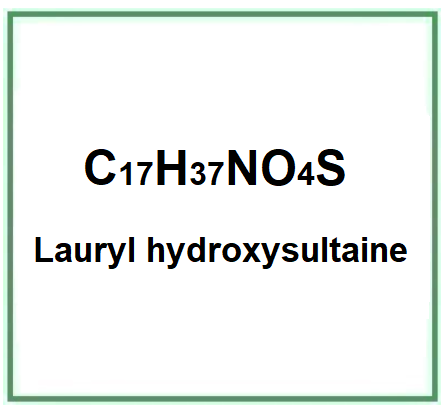Lauryl Hydroxysultaine is a chemical compound, consists of a sultainic structure with an alkyl group, a sulfopropyl quaternary ammonium salt, and a hydroxyl group. It is an amphoteric compound, meaning it can behave both as an acid and a base.
The name describes the structure of the molecule:
- "Lauryl" indicates the presence of a lauryl group, which is an alkyl group derived from lauric acid.
- "Hydroxysultaine" indicates the presence of a sultaine functional group with a hydroxy group.
Description of raw materials used in production and their functions.
- Lauryl alcohol. A 12-carbon alkyl chain, it acts as the backbone of the molecule.
- Isothionate chloride. Provides the hydroxysultaine group when it reacts with lauryl alcohol.
Step-by-step summary of industrial chemical synthesis process.
- Reaction of Lauryl alcohol with Isothionate chloride. In the presence of a base, the lauryl alcohol reacts with isothionate chloride to form the lauryl isothionate intermediate.
- Hydrolysis. The intermediate is hydrolyzed in the presence of a base to form lauryl hydroxysultaine.
- Purification. The solution containing lauryl hydroxysultaine is purified through techniques such as distillation or filtration to remove impurities and by-products.
It appears as a colorless or yellowish liquid.

What it is for and where
Cosmetics
Antistatic agent. Static electricity build-up has a direct influence on products and causes electrostatic adsorption. The antistatic ingredient reduces static build-up and surface resistivity on the surface of the skin and hair.
Cleansing agent. Ingredient that cleanses skin without exploiting the surface-active properties that produce a lowering of the surface tension of the stratum corneum.
Surfactant - Foam booster. It has the effect of introducing gas bubbles into the water and affects the cleaning process by helping to spread the cleanser. Since sebum has an inhibiting effect on the bubble, more foam is produced in the second shampoo.
Hair conditioning agent. A significant number of ingredients with specific and targeted purposes may co-exist in hair shampoo formulations: cleansers, conditioners, thickeners, matting agents, sequestering agents, fragrances, preservatives, special additives. However, the indispensable ingredients are the cleansers and conditioners as they are necessary and sufficient for hair cleansing and manageability. The others act as commercial and non-essential auxiliaries such as: appearance, fragrance, colouring, etc. Hair conditioning agents have the task of increasing shine, manageability and volume, and reducing static electricity, especially after treatments such as colouring, ironing, waving, drying and brushing. They are, in practice, dispersants that may contain cationic surfactants, thickeners, emollients, polymers. The typology of hair conditioning agents includes: intensive conditioners, instant conditioners, thickening conditioners, drying conditioners. They can perform their task generally accompanied by other different ingredients.
Skin conditioning agent. It is the mainstay of topical skin treatment as it has the function of restoring, increasing or improving skin tolerance to external factors, including melanocyte tolerance. The most important function of the conditioning agent is to prevent skin dehydration, but the subject is rather complex and involves emollients and humectants that can be added in the formulation.
Surfactant - Cleansing agent. Cosmetic products used to cleanse the skin utilise the surface-active action that produces a lowering of the surface tension of the stratum corneum, facilitating the removal of dirt and impurities.
Viscosity control agent. It controls and adapts, Increasing or decreasing, viscosity to the required level for optimal chemical and physical stability of the product and dosage in gels, suspensions, emulsions, solutions.
Commercial Applications
Cosmetics and Personal Care. Lauryl Hydroxysultaine is commonly used in shampoos, body washes, facial cleansers, and other skin care products for its foaming and conditioning properties.
Household Cleaning. This ingredient can be found in detergents and other cleaning products due to its cleaning capabilities and foaming properties..
Textile Industry. It might be used in some textile processes to enhance the solubility and efficacy of other chemical ingredients.
- Molecular Formula C17H37NO4S
- Molecular Weight 351.5 g/mol
- CAS 13197-76-7
- UNII 176KKP31OZ
- EC Number 236-164-7
- DTXSID2050035
Synonyms:
3-(Dodecyldimethylammonio)-2-hydroxypropane-1-sulfonate
N,N-Dimethyl-N-dodecyl-N-(2-hydroxy-3-sulfopropyl)ammonium betaine
![]() Lauryl Hydroxysultaine
Lauryl Hydroxysultaine 




